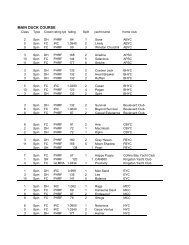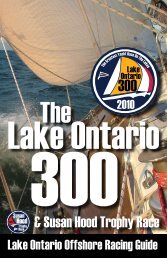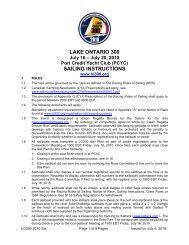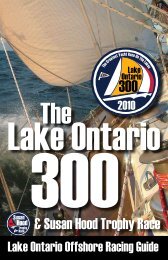Create successful ePaper yourself
Turn your PDF publications into a flip-book with our unique Google optimized e-Paper software.
Page 34 <strong>Lake</strong> <strong>Ontario</strong> <strong>Offshore</strong> Racing Guide <strong>Lake</strong> <strong>Ontario</strong> <strong>Offshore</strong> Racing Guide Page 35<br />
Getting Ready for<br />
enjoy exceptional sailing and work towards a common goal without the hectic<br />
course racing and parties of most regattas.<br />
<strong>Offshore</strong> Racing<br />
First time participants in the <strong>Lake</strong> <strong>Ontario</strong> <strong>300</strong> are encouraged to set realistic<br />
goals. For some, simply finishing the race constitutes a tremendous achievement.<br />
Newbies are also encouraged to test their skills on a shorter race or an<br />
overnight race like the Susan Hood Trophy Race to determine their comfort<br />
level with offshore / long distance racing. Those that are now to the race may<br />
also elect to compete in a white sails division, and sail on the Scotch Bonnet<br />
Island Course.<br />
The <strong>Lake</strong> <strong>Ontario</strong> <strong>300</strong> is acknowledged as the longest annually held<br />
fresh water race in the world at <strong>300</strong> nautical miles and can be different<br />
things to different participants, taking on definitions ranging from<br />
an unbelievable thrill, the greatest challenge on the lakes, a marathon, an<br />
adventure, a test of skills or for some a non-stop cruise.<br />
The LO<strong>300</strong> is the Boston Marathon of <strong>Lake</strong> <strong>Ontario</strong>’s yachting events, but there<br />
are many other offshore races here that will challenge your sailing skills and<br />
ambitions. These are listed on page 6 of this guide, and you can learn more<br />
about them by contacting the host club or organizing authority.<br />
Typically, offshore racing refers to long distance ocean racing but can apply to<br />
events on large bodies of water such as the Great <strong>Lake</strong>s. Key features that help<br />
define an offshore race include:<br />
1. A course without temporary marks adjusted to accommodate the wind<br />
2. Long distance legs, usually at least 10 to 15 nm in length<br />
3. Non-stop racing that frequently includes racing at night<br />
4. Racing that is not postponed due to adverse weather conditions<br />
Races that incorporate these attributes take on a personality of their own and if<br />
they are annual events, vary significantly year after year. The challenges different<br />
from short course racing, requiring a different set of tactics, boat handling,<br />
and seamanship skills. The skills needed vary dramatically depending on the<br />
time of year during which the race is run, it’s overall distance and the navigational<br />
obstacles encountered on the course.<br />
Over longer distances, currents and uneven wind conditions become more<br />
of a factor and amplify the effects of tactical decisions made during the race.<br />
Depending on your location to the rest of the fleet your boat may experience a<br />
very different weather pattern thus impacting performance for better or perhaps<br />
for worse. At the same time, the longer distance affords greater opportunity to<br />
make up lost time and/or distance. In an offshore or long distance race it is<br />
common to hear many different versions on the same race for the same year.<br />
This means each boat is constantly challenged to race their best and navigate<br />
the course based on the weather conditions they are facing. <strong>Offshore</strong> racing is<br />
a true test of sailing ability.<br />
Most sailors entering into an offshore race are wanting a new challenge and<br />
looking to test their skills against the other participants. Some, however, are<br />
looking for a more relaxed racing experience that allows time for the crew to<br />
There are a<br />
number of things<br />
to consider<br />
before entering<br />
an offshore race.<br />
These will affect<br />
the outcome of<br />
the race and your<br />
enjoyment of the<br />
experience:<br />
• Determine<br />
your crew<br />
size: double<br />
handed is<br />
popular, in<br />
part because<br />
This image of Scotch Bonnet Island has been<br />
provided by Marinas.com<br />
of the challenge, but also for the simple reason that you do not have to<br />
coordinate a full crew. It is more challenging but your boat needs to be<br />
suitable for short-handed sailing and your partner needs to be committed<br />
and experienced<br />
• Make sure you have the experience necessary to compete. Navigation,<br />
tactics, shift management, night sailing, and even menu planning take on a<br />
different characteristic in an offshore race and it is important that your crew<br />
has some experience in the various areas<br />
• Set your boats rules on safety, shift changes, night time sailing. It is important<br />
on a long race to adhere to a policy of wearing harnesses and PFDs at<br />
a chosen time before dark and keeping regular shift changes every 3 to 4<br />
hours depending on the boat and crew. Harnesses and PFDs should also<br />
be worn at all times in heavy weather and through the night on watch<br />
• It is important to understand the strengths of individual crew members i.e.<br />
some need lots of sleep while others can survive on very little<br />
• Determine whether you wish to compete white sail only or with flying sails.<br />
This is important and ties into the fully crewed decision. White sail, either<br />
double handed or fully crewed is a great way to get started with offshore










